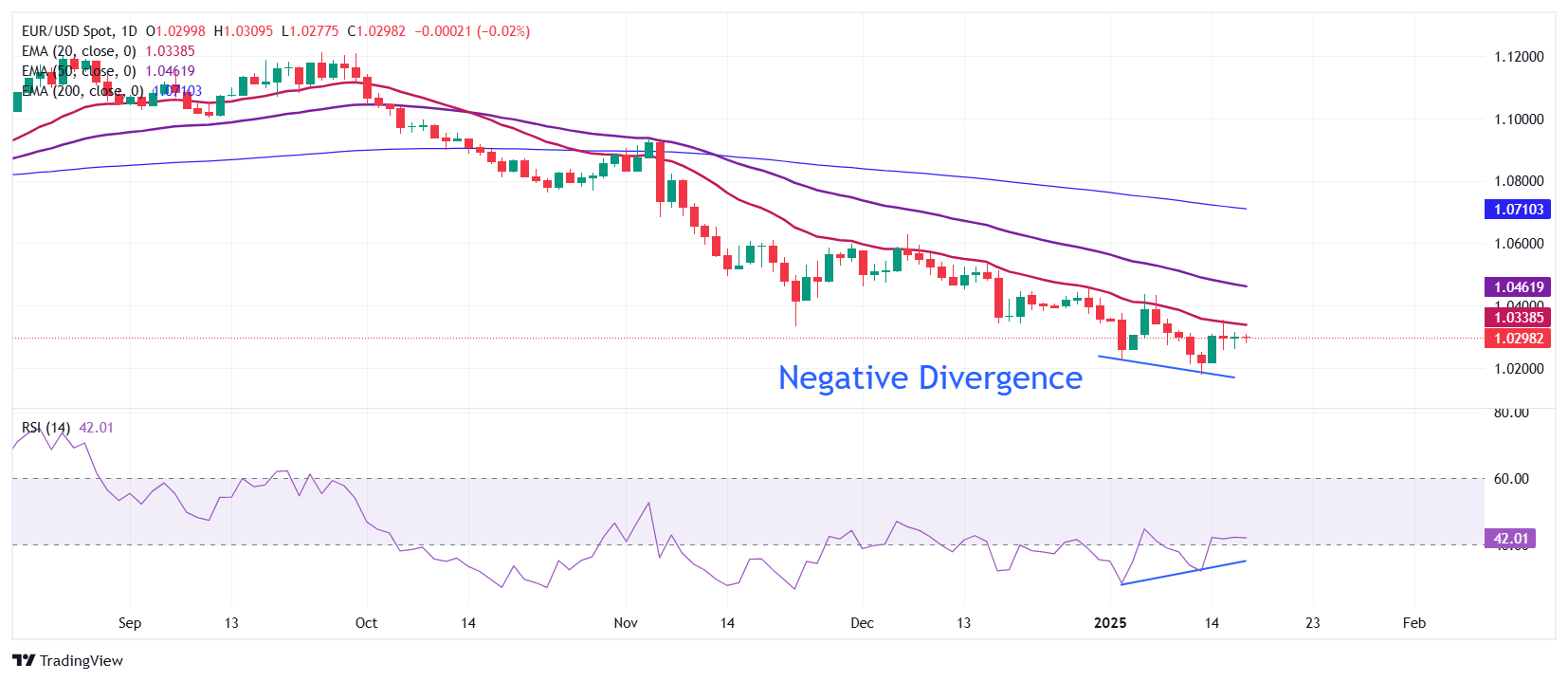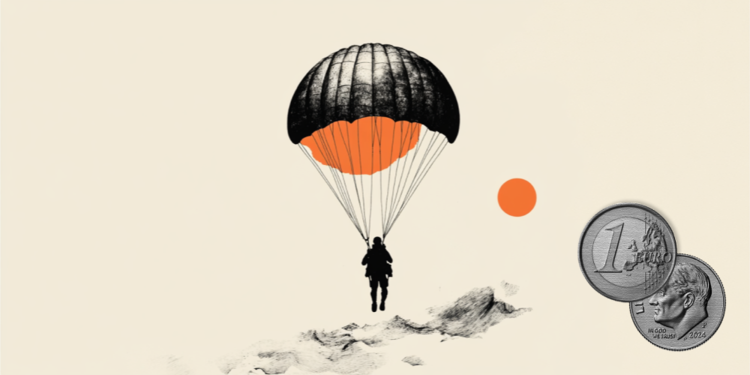EUR/USD slides as US Dollar gains with Trump's inaugration on the horizon
- EUR/USD falls sharply to near 1.0270 as investors shift focus to the US President-elect Donald Trump’s inauguration ceremony.
- Trump is expected to release policies on raising tariffs and lowering taxes soon after re-joining the White House.
- The ECB minutes showed that officials debated over reducing the Deposit Facility rate by 50 bps in December.
EUR/USD declines to near 1.0270 in Friday’s North American session. The major currency pair oscillates inside Thursday’s trading range, with investors focusing on United States (US) President-elect Donald Trump’s inauguration on Monday.
Investors await Trump’s announcement of new economic policies for fresh cues about the United States (US) economic outlook and the likely global trade environment. Market experts believe that Trump’s policies will boost inflation and economic growth and lead to a global trade war.
While testifying at a Senate Finance Committee on Wednesday, Trump’s treasury pick, Scott Bessent, said there is an urgent need to conclude the current tax regime to avoid the burden of a $4 trillion tax on the middle class. "If we do not renew and extend, then we will be facing an economic calamity,” Bessent said. He also supported Trump’s protectionist policies as they would help combat unfair trade practices and increase the US’s negotiating power.
Meanwhile, the US Dollar Index (DXY), which tracks the Greenback’s value against six major currencies, ticks higher and holds the key support of 109.00. The US Dollar remains broadly firm even though traders started pricing in at least one interest rate cut by the Federal Reserve (Fed) this year. Traders have raised Fed dovish bets as the core Consumer Price Index (CPI) – which excludes volatile food and energy prices – decelerated to 3.2% in December, the lowest level in over four years.
US Dollar PRICE Today
The table below shows the percentage change of US Dollar (USD) against listed major currencies today. US Dollar was the strongest against the New Zealand Dollar.
| USD | EUR | GBP | JPY | CAD | AUD | NZD | CHF | |
|---|---|---|---|---|---|---|---|---|
| USD | 0.29% | 0.52% | 0.45% | 0.39% | 0.66% | 0.71% | 0.35% | |
| EUR | -0.29% | 0.22% | 0.18% | 0.09% | 0.37% | 0.42% | 0.05% | |
| GBP | -0.52% | -0.22% | -0.06% | -0.13% | 0.15% | 0.19% | -0.16% | |
| JPY | -0.45% | -0.18% | 0.06% | -0.06% | 0.20% | 0.25% | -0.11% | |
| CAD | -0.39% | -0.09% | 0.13% | 0.06% | 0.26% | 0.32% | -0.04% | |
| AUD | -0.66% | -0.37% | -0.15% | -0.20% | -0.26% | 0.06% | -0.31% | |
| NZD | -0.71% | -0.42% | -0.19% | -0.25% | -0.32% | -0.06% | -0.36% | |
| CHF | -0.35% | -0.05% | 0.16% | 0.11% | 0.04% | 0.31% | 0.36% |
The heat map shows percentage changes of major currencies against each other. The base currency is picked from the left column, while the quote currency is picked from the top row. For example, if you pick the US Dollar from the left column and move along the horizontal line to the Japanese Yen, the percentage change displayed in the box will represent USD (base)/JPY (quote).
Daily digest market movers: EUR/USD weakens as ECB officials support more interest rate cuts
- EUR/USD declines due to US Dollar's strength. The Euro (EUR) performs weakly only against the US Dollar but is firm in comparison with other peers amid solid European Central Bank (ECB) dovish bets. Traders are pricing in a 25 basis points (bps) interest rate cut by the ECB in each of the following four policy meetings amid growing concerns over the Eurozone economic outlook and price pressures remaining under control.
- ECB officials are also comfortable with more interest rate cuts. The ECB minutes of the December meeting showed on Thursday that policymakers discussed the pace of policy-easing this year more than pausing or continuing the interest rate cut cycle. The minutes also showed that officials heavily debated announcing a larger-than-usual interest rate cut of 50 bps to provide insurance against the downside risks to growth, which are exacerbated by global and domestic political uncertainties. However, the ECB cut interest rates by 25 bps.
- There was a clear shift of communication from the “return of inflation to ECB’s target of 2%” to “keeping inflation sustainably at their target”. The ECB minutes also showed that officials were worried about growing risks to inflation undershooting the central bank’s target of 2%.
- Meanwhile, worries about the EUR/USD pair falling to parity have accelerated as Trump’s return to the White House is on the horizon. Trump is expected to decide to push import tariffs higher soon, a scenario that will be unfavorable for the European Union (EU) export sector.
- On Thursday, ECB policymaker and the Governor of the Bank of Greece Yannis Stournaras said that policy should continue with a "series of rate cuts" at the next meetings. His dovish stance was based on the assumption that fresh protectionist measures imposed by the US could lead to "below-target Eurozone inflation."
Technical Analysis: EUR/USD declines to near 1.02970

EUR/USD slides to near 1.0270 on Friday after failing to hold the key support of 1.0300. The major currency pair struggles to hold the recovery move that came due to divergence in momentum and price action. The 14-day Relative Strength Index (RSI) formed a higher low near 35.00, while the pair made lower lows.
However, the outlook of the shared currency pair is still bearish as all short-to-long-term Exponential Moving Averages (EMAs) are sloping downwards.
Looking down, Monday’s low of 1.0175 will be the key support zone for the pair. Conversely, the January 6 high of 1.0437 will be the key barrier for the Euro bulls.
ECB FAQs
The European Central Bank (ECB) in Frankfurt, Germany, is the reserve bank for the Eurozone. The ECB sets interest rates and manages monetary policy for the region. The ECB primary mandate is to maintain price stability, which means keeping inflation at around 2%. Its primary tool for achieving this is by raising or lowering interest rates. Relatively high interest rates will usually result in a stronger Euro and vice versa. The ECB Governing Council makes monetary policy decisions at meetings held eight times a year. Decisions are made by heads of the Eurozone national banks and six permanent members, including the President of the ECB, Christine Lagarde.
In extreme situations, the European Central Bank can enact a policy tool called Quantitative Easing. QE is the process by which the ECB prints Euros and uses them to buy assets – usually government or corporate bonds – from banks and other financial institutions. QE usually results in a weaker Euro. QE is a last resort when simply lowering interest rates is unlikely to achieve the objective of price stability. The ECB used it during the Great Financial Crisis in 2009-11, in 2015 when inflation remained stubbornly low, as well as during the covid pandemic.
Quantitative tightening (QT) is the reverse of QE. It is undertaken after QE when an economic recovery is underway and inflation starts rising. Whilst in QE the European Central Bank (ECB) purchases government and corporate bonds from financial institutions to provide them with liquidity, in QT the ECB stops buying more bonds, and stops reinvesting the principal maturing on the bonds it already holds. It is usually positive (or bullish) for the Euro.
Forex News
Keep up with the financial markets, know what's happening and what is affecting the markets with our latest market updates. Analyze market movers, trends and build your trading strategies accordingly.
